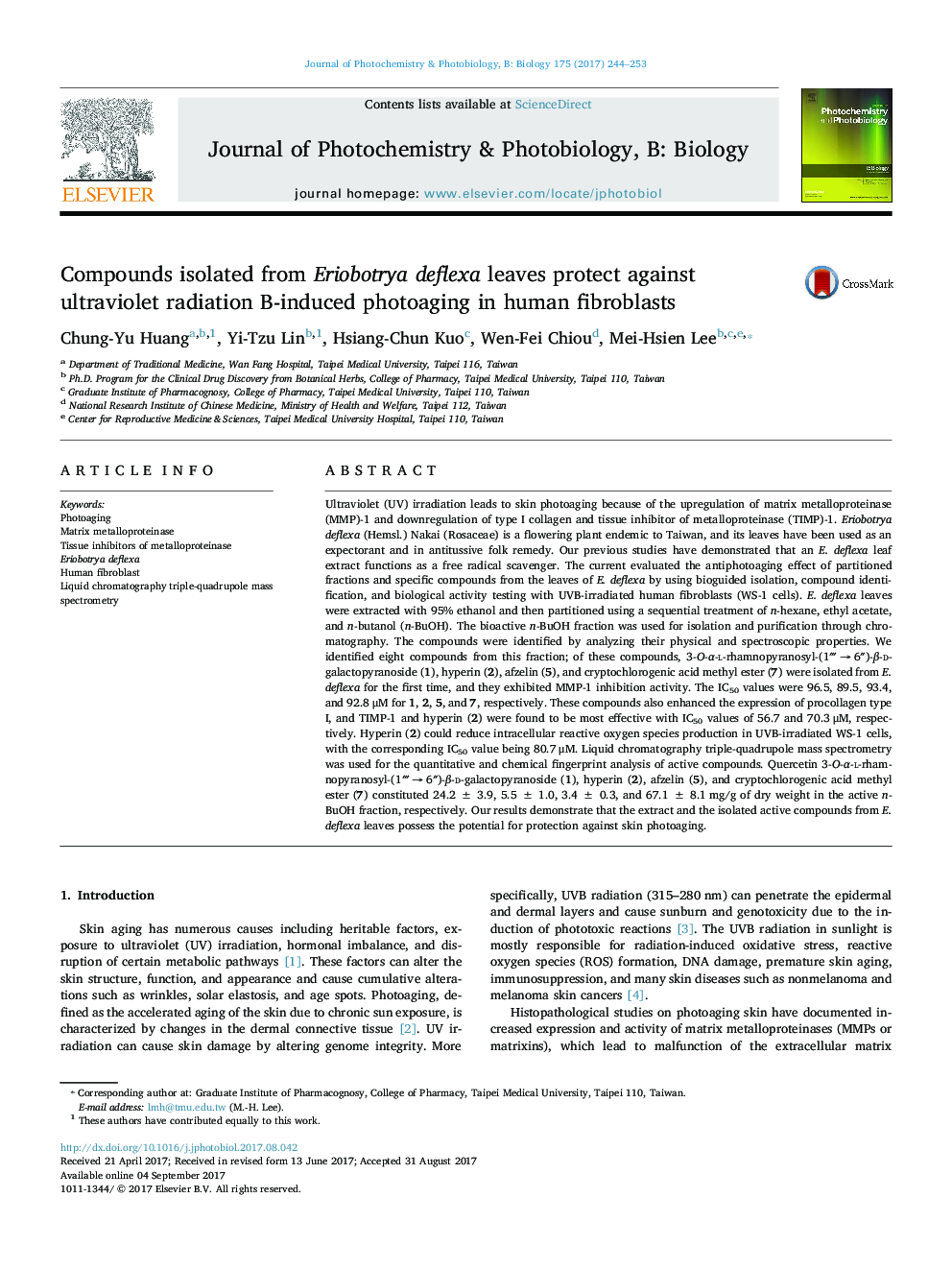| کد مقاله | کد نشریه | سال انتشار | مقاله انگلیسی | نسخه تمام متن |
|---|---|---|---|---|
| 6452557 | 1418058 | 2017 | 10 صفحه PDF | دانلود رایگان |

- Using bio-guided method, 4 active compounds were isolated from Eriobotrya deflexa.
- Activity of these compounds was evaluated using UV-B irradiated WS-1 cells.
- Hyperin reduced MMP-1, intracellular ROS and increased procollagen type-I, TIMP-1.
- LC-MS/MS was used for the quantitative analysis of compounds in active fraction.
Ultraviolet (UV) irradiation leads to skin photoaging because of the upregulation of matrix metalloproteinase (MMP)-1 and downregulation of type I collagen and tissue inhibitor of metalloproteinase (TIMP)-1. Eriobotrya deflexa (Hemsl.) Nakai (Rosaceae) is a flowering plant endemic to Taiwan, and its leaves have been used as an expectorant and in antitussive folk remedy. Our previous studies have demonstrated that an E. deflexa leaf extract functions as a free radical scavenger. The current evaluated the antiphotoaging effect of partitioned fractions and specific compounds from the leaves of E. deflexa by using bioguided isolation, compound identification, and biological activity testing with UVB-irradiated human fibroblasts (WS-1 cells). E. deflexa leaves were extracted with 95% ethanol and then partitioned using a sequential treatment of n-hexane, ethyl acetate, and n-butanol (n-BuOH). The bioactive n-BuOH fraction was used for isolation and purification through chromatography. The compounds were identified by analyzing their physical and spectroscopic properties. We identified eight compounds from this fraction; of these compounds, 3-O-α-l-rhamnopyranosyl-(1â´Â â 6â³)-β-d-galactopyranoside (1), hyperin (2), afzelin (5), and cryptochlorogenic acid methyl ester (7) were isolated from E. deflexa for the first time, and they exhibited MMP-1 inhibition activity. The IC50 values were 96.5, 89.5, 93.4, and 92.8 μM for 1, 2, 5, and 7, respectively. These compounds also enhanced the expression of procollagen type I, and TIMP-1 and hyperin (2) were found to be most effective with IC50 values of 56.7 and 70.3 μM, respectively. Hyperin (2) could reduce intracellular reactive oxygen species production in UVB-irradiated WS-1 cells, with the corresponding IC50 value being 80.7 μM. Liquid chromatography triple-quadrupole mass spectrometry was used for the quantitative and chemical fingerprint analysis of active compounds. Quercetin 3-O-α-l-rhamnopyranosyl-(1â´Â â 6â³)-β-d-galactopyranoside (1), hyperin (2), afzelin (5), and cryptochlorogenic acid methyl ester (7) constituted 24.2 ± 3.9, 5.5 ± 1.0, 3.4 ± 0.3, and 67.1 ± 8.1 mg/g of dry weight in the active n-BuOH fraction, respectively. Our results demonstrate that the extract and the isolated active compounds from E. deflexa leaves possess the potential for protection against skin photoaging.
Graphical Abstract159
Journal: Journal of Photochemistry and Photobiology B: Biology - Volume 175, October 2017, Pages 244-253